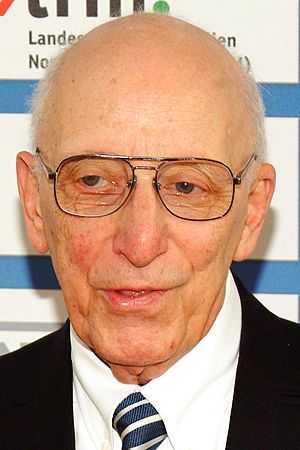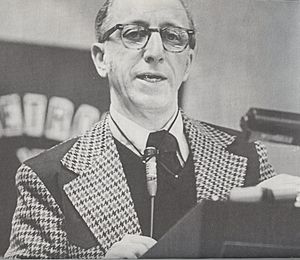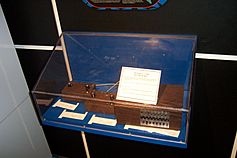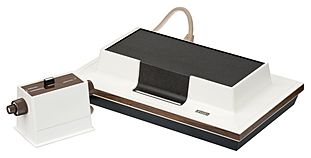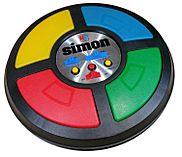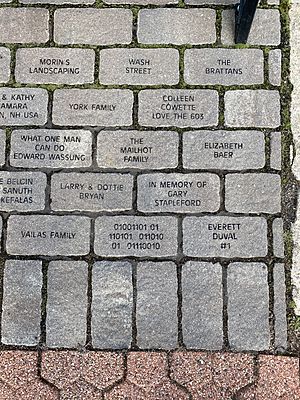Ralph H. Baer facts for kids
Ralph Henry Baer (born Rudolf Heinrich Baer; March 8, 1922 – December 6, 2014) was a German-American inventor and engineer. He is often called "the Father of Video Games." Baer created the first home video game console, the Magnavox Odyssey. This invention helped start the huge video game industry we know today.
His family moved from Germany to the United States before World War II. Baer later served in the American military. He became very interested in electronics. While working as an engineer at Sanders Associates, he got the idea to play games on a TV screen in 1966. With his company's help, he built several test versions. One of these was called the "Brown Box." This "Brown Box" became the plan for the first home video game console. It was later sold by Magnavox as the Magnavox Odyssey. Baer also helped design other game systems and electronic games, like the popular Simon. He continued inventing until he passed away in 2014, holding over 150 patents.
In 2006, Baer received the National Medal of Technology. This award honored his amazing work in creating and selling interactive video games. His inventions led to many new uses and huge industries in both entertainment and education.
Contents
Ralph Baer's Early Life
Ralph Baer was born in 1922 in Pirmasens, Germany. His birth name was Rudolf Heinrich Baer. His family was Jewish. When he was 14, he had to leave his school because of new laws against Jewish people in Nazi Germany. He then went to an all-Jewish school.
In 1938, his family moved from Germany to New York City. They left just two months before a terrible event called Kristallnacht. Baer was a teenager at the time. He later became a citizen of the United States.
Education and Military Service
In the U.S., Baer taught himself many things. He worked in a factory, earning twelve dollars a week. After seeing an ad for electronics education, he decided to study that field. He graduated as a radio service technician in 1940.
In 1943, he joined the military for World War II. He worked in military intelligence in London. After the war, in 1946, he returned home. He then used the G.I. Bill to go to college. In 1949, he earned a Bachelor of Science degree in Television Engineering. This was a very new and special degree at the time.
Baer's Career and Inventions
After college, Baer worked as a chief engineer for Wappler, Inc. He designed medical equipment there. In 1951, he became a senior engineer at Loral Electronics. He designed power line equipment for IBM. From 1952 to 1956, he was a chief engineer and vice president at Transitron, Inc.
In 1956, Baer joined Sanders Associates, a company that made defense products. He stayed there until he retired in 1987. At Sanders, he managed about 500 engineers. They developed electronic systems for military use. It was during this time that he thought of creating a home video game console. He went on to make the first commercial video game consoles. He also patented many other advances in video games and electronic toys.
The First Home Video Game Console
Baer is known as the inventor of video games, especially the idea of playing games at home on a TV. In 1966, at Sanders Associates, he started exploring this idea. He had first thought of it in 1951, but his company at the time wasn't interested.
In 2007, Baer said that he realized many people now owned TVs. This meant there was a big chance to create new uses for them. He wrote a four-page plan and convinced his boss to let him try. He received US$2,500 and help from two other engineers, Bill Harrison and Bill Rusch.
They created the "Brown Box" console. It was named this because they wrapped it in brown tape to make it look like wood. Baer said that when he showed an early version to a patent examiner, "within 15 minutes, every examiner on the floor of that building was in that office wanting to play the game." The Brown Box was patented in 1973.
Baer looked for a company to sell his system. Many TV makers weren't interested. But in 1971, Magnavox licensed it. It was renamed the Magnavox Odyssey and came out in May 1972. It was a big success for Sanders, selling over 340,000 units.
Baer also created the first light gun for home TVs. It was sold with a game for the Odyssey called Shooting Gallery. This light gun was the first extra device for a video game console.
Competition and Other Inventions
The success of the Odyssey led other companies to make games. One was Atari, Inc., led by Nolan Bushnell. Bushnell saw Baer's successful games. He then created the first arcade machine in 1972, based on Baer's Table Tennis idea. This became the famous game Pong.
Sanders and Magnavox sued Atari and others for using Baer's ideas without permission. Bushnell settled and got a license to use Baer's patents. This allowed Atari to continue making video games. Bushnell then made Atari a leader in both home and arcade games.
There was a long debate about who was the true "father of video games." Baer was called the father of the home video game console. Bushnell was credited with creating the arcade machine idea. When Baer died, Bushnell said that Baer's "contributions to the rise of videogames should not be forgotten."
Baer also helped create other popular electronic games. With Howard J. Morrison, he developed Simon (1978) and Super Simon (1979) for Milton Bradley. These were electronic games where players had to remember patterns of lights and sounds. They were very popular for many years. Baer also made a similar game called "Maniac" in 1979.
In 2006, Baer gave many of his early inventions and papers to the Smithsonian Institution. He continued to work on electronics even after his wife passed away. By the time he died, Baer had over 150 patents. These included patents for electronic greeting cards and tracking systems for submarines.
Awards and Recognition
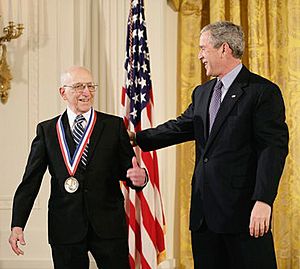
Ralph Baer is known as a true pioneer in video games. He received many awards for his work:
- The G-Phoria Legend Award (2005)
- The IEEE Masaru Ibuka Consumer Electronics Award (2008)
- The Game Developers Conference Developers Choice "Pioneer" award (2008)
- The IEEE Edison Medal (2014)
After he passed away, he was given the Pioneer Award by the Academy of Interactive Arts and Sciences in 2015.
On February 13, 2006, President George W. Bush gave Baer the National Medal of Technology. This was for his amazing work in creating and selling interactive video games. On April 1, 2010, Baer was added to the National Inventors Hall of Fame.
Baer once said that because the President gave him an award and he was in the Inventors Hall of Fame, he didn't feel forgotten.
On May 10, 2019, a statue of Ralph Baer was placed in Arms Park in Manchester, New Hampshire. The area around it was renamed Baer Square. On April 8, 2021, the United States Mint announced that Baer and his "Handball" game would be honored on a special coin as part of the American Innovation dollars program.
Memorial Stones at Baer Square
The memorial was paid for by a special fundraising effort called Kickstarter. On the ground in front of Ralph Baer's statue, there are stones with messages carved into them. People who donated a certain amount of money could choose the text for their stone. One stone has a message written in binary code. This code translates to the word Muir, which is the name of the person who donated for that stone, Kelley Muir.
See also
 In Spanish: Ralph H. Baer para niños
In Spanish: Ralph H. Baer para niños


